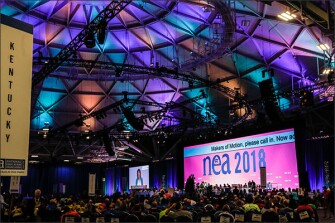
The nation’s largest teachers’ union is seeing the first signs of a membership exodus, according to a report from the news site The 74 Million.
The National Education Association has lost about 17,000 members since its last update in April, according to an internal document obtained by Mike Antonucci, a long-time union analyst who now writes for the 74. This membership loss is most likely due to a Supreme Court decision in June that prohibited public-sector unions from charging fees to workers who are not members of the union.
Before the high court ruling in Janus v. AFSCME, workers who didn’t want to join the union still had to pay “agency” or “fair share” fees to cover the cost of collective bargaining. However, those fees often cost nearly as much as a full membership, so many people went ahead and became members. Now, workers can exit the union and not have to pay any fee as a nonmember—so unions have predicted significant membership declines.
The NEA now stands at just over 3 million members, Antonucci reported. But the membership loss is likely to continue—over the summer, the NEA predicted a loss of more than 300,000 members over two years.
NEA spokeswoman Celeste Busser said in an email to Education Week that the union won’t have final, updated membership numbers until the end of the year.
“It is too early to tell the impact of the Janus decision,” she said.
See also: After Supreme Court Blow, Defiant Union Looks Ahead
After the Supreme Court’s ruling, the NEA immediately lost its nearly 88,000 agency-fee payers, a blow to the union’s coffers. The NEA has already cut its two-year budget by $50 million, but Antonucci reports that union officials are looking for additional ways to reduce spending—mainly by shortening the annual convention.
While the NEA’s Representative Assembly, in which union delegates vote on proposals, policy statements, and the budget, would continue to last four days, the union plans to eliminate or consolidate some of the meetings and activities beforehand. Cutting two days of the annual convention would save the NEA $1 million, Antonucci wrote.
“It is correct that we have for some time now been working to ensure the RA is what it is intended to be, a business meeting,” Busser said. “However, throughout the years, more and more has been added [to the schedule]. This shortened agenda is intended to allow us to focus more intentionally on the actual business of the RA.”
Attracting and retaining members will be a priority for the union. NEA President Lily Eskelsen García told Education Week over the summer that she hoped to encourage former agency fee-payers to become full members through individual conversations. However, union officials have some competition: Conservative groups have launched messaging campaigns to convince teachers to drop their union membership.
There is also a rash of legal challenges facing teachers’ unions—there are at least 15 lawsuits against the NEA and its affiliates. Some of these challenges are pushes for teachers to be reimbursed for the agency fees they paid before the Supreme Court decision, and others are challenges to time-limited windows during which teachers can opt out of having membership dues deducted from their paychecks. It will be expensive for the NEA to fight these cases in court.
Unions have been preparing for the anticipated loss of members through “recommit to the union” campaigns and by pushing for friendly legislation that gives the unions better access to potential members—for instance, by requiring that new teachers meet with their union representatives within a month of being hired or by providing unions with teachers’ contact information.
Still, researchers have suggested that teachers’ unions may be “permanently crippled” in the wake of the Supreme Court decision. To adapt, researchers wrote, unions will likely become more political and renew their focus on teacher voice.
Image of NEA’s annual convention, by Scott Iskowitz/National Education Association


